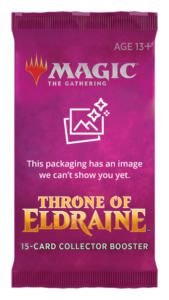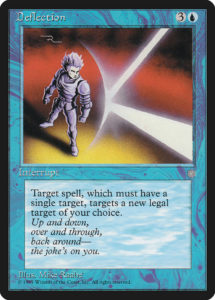This weekend Mark Rosewater showed us images of the fall expansion, Throne of Eldraine, a set where Camelot meets Grimm’s Fairy Tales. Eldraine is the home of the Kenrith twins of Battlebond fame, and a top-down set full of familiar folkflore.
He also showed off a variety of new booster products, a new twist on Masterpieces, and introduced showcase cards (every set will have select cards with an alternate frame and artwork). But perhaps more importantly of all, Rosewater also provided us a glimpse into the future of tabletop Magic:
WotC has reorganized
While this announcement was only two paragraphs long in an article full of information about boosters, it can have enormous ramifications.
Once upon a time, there was design and development, along with creative, digital, and the less well-known but still essential teams like legal and brand. Wizards has restructured itself into a variety of studios. Tabletop Magic now contains all of design, development, creative, and art. This is likely a massive change, but also an obscure one. It’s not immediately clear how this changes Magic or what new opportunities this creates for Magic. Splitting the team into different studios could ameliorate or exacerbate communication issues. It could mean that Magic Digital assembles (or already has) its own design team, that there might be Arena-exclusive Magic sets or products.
However, one thing is absolutely, abundantly certain: tabletop Magic is alive and thriving. Mark Rosewater is embedded in the tabletop studio along with most of who we’d recognize as the people who make Magic. They are experimenting with new ways to satisfy the analog player base without sacrificing anything that they already have access to. Magic is thriving and expanding its analog product lines to accommodate its large audiences. This should be phenomenally great news for players.
New Forms of Booster
So, what do these changes mean?
Well, for most of Magic’s history there was the booster pack. One-size-fits-all, it was the go-to for acquiring a random assortment of Magic cards. There was also the tournament pack (once the only means of reliably procuring basic lands), but that hasn’t been around in a decade. There have been recent experiments with new forms of boosters. Some have been successful enough that we’re not only seeing new forms of boosters, we’re also witnessing the rebranding of the familiar booster as the Draft Booster.
To be clear: nothing major about booster packs is changing. They will still very likely be the most common form of pack players interact with. The only actual changes are minor and all-upside:
- More foils. This already started with Core 2020, but a third of all boosters now contain a foil (up from just under a quarter). Foils are now a bit more common. If you like foils, this is awesome! If you dislike foils, this is a minor change.
- More special cards. From Battle for Zendikar to Hour of Devastation, boosters could contain extra-rare cards with alternate artwork and special borders (that often were valuable older cards not legal in Standard). We will once again be getting special versions of cards in boosters—borderless Planeswalkers and “showcase” cards (in Thrones of Eldraine boosters, these will just be cards from that set) in an alternate frame. Masterpieces had some issues that these have taken into account, but they also did the good work of keeping the price of Standard down.
In addition to the draft booster, we’re seeing theme boosters become permanent fixtures of Magic and the introduction of collector boosters. Theme boosters seem more focused towards casual players and those looking to build up an initial collection, whereas collector boosters are going to be expensive products for collectors and folks who like playing the lottery of cracking packs in search of valuable and rare cards.
Mythic edition and theme boosters have demonstrated an interest in both such products and it will be interesting seeing how these satisfy players and change how people interact with the game. As a cube owner, I know I’m probably going to be pretty happy that collector boosters are out in the wild even if I never crack one—I’m still waiting on more details before taking that plunge.
So what?
The announcement, while substantial, wasn’t exactly what I and many others expected. This is the latest announcement of a Standard set in recent memory, and given how spoiler-packed things have been, it was surprising not to see a single card. Yes, it’s incredibly early for spoiler season to come; but there was a lot of buildup to ultimately see some awesome art and learn about new boosters and goodies inside them.
This announcement ultimately didn’t feel super targeted to me. Yes, I like foils; and yes, I’ve cracked some packs in my time. But I don’t know whether I’ll pick up any collector boosters and play that lottery. I know that theme boosters are not for me. I’m most excited about Wizards’ restructuring and clear dedication to tabletop Magic in an era where digital Magic seems like it could eclipse tabletop.
Still, there is the feeling that while Wizards is clearly focused on tabletop Magic players as a whole; by spreading the umbrella to cover more people, the focus shifts away from the most privileged players. Let’s be frank: enfranchised and competitive players have long been the primary beneficiaries of Magic’s attention. We constitute a tiny fraction of Magic’s playerbase and Magic expanding its product lines to accommodate a more diverse array of people benefits everyone. The more people that play and enjoy Magic, the healthier the game is, the broader and stronger our communities can be, and the more opportunities we have to play. That’s a lesson I think a large portion of the world (especially we privileged folks) could benefit from.
That said, not everything is completely rosy. I can see how frustration about the confusing state of organized play could bleed into discussions about new forms of booster packs. It’s hard not having grand prix coverage. Scant coverage makes it easier to disengage from the pro narrative, which makes Mythic Championships harder to care about. The dearth of MCQs and death of PPTQs makes it harder to justify buying cards to practice for and travel to MagicFests.
All of this is to say that Magic is currently in transition. It’s probably more healthy than it’s ever been thanks to Arena, but tabletop is also clearly excelling based on the formation of a tabletop studio. The brand is strong enough to get a Netflix series from the Russo brothers. Magic as a whole is doing great. Tournament Magic has seen much better days, or perhaps it too is doing well but I and many like me are unable to see that success. We just saw the least-attended Grand Prix in a decade, but it was also won by LSV, one of Magic’ biggest celebrities. Time will tell what happens with organized play.
I’m excited to witness Magic expand into new markets and satisfy underserved playerbases. And I am optimistic that future products more focused on me (like Modern Horizons) will be around longer than a week. Until then, and as always, thanks for reading.
—Zachary Barash is a New York City-based game designer and the commissioner of Team Draft League. He designs for Kingdom Death: Monster, has a Game Design MFA from the NYU Game Center, and does freelance game design. When the stars align, he streams Magic (but the stars align way less often than he’d like).
His favorite card of the month is Tajuru Pathwarden. It’s a unique combination of numbers that’d never been done before in quite that way and was one of a few cards that turned green from the worst color in Battle for Zendikar into one of the stronger colors in Oath of the Gatewatch. It can be really nice when a french vanilla creature does a lot of work.




